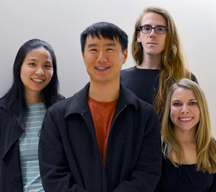TSRI Team Comes Together with Rare Disease Community
By Madeline McCurry-Schmidt
Don’t worry, science fiction fans, the machines aren’t taking over quite yet. It turns out humans still beat computers at reading and comprehending text.
In fact, your ability to read this very sentence means you could join a new project led by researchers at The Scripps Research Institute (TSRI). Volunteers in their online program, Mark2Cure, read sections of scientific studies to identify important terms.
“If you can read, you can help,” explained TSRI Associate Professor Andrew Su, leader of Mark2Cure, in a presentation at Stanford University’s recent Big Data in Biomedicine 2015 conference.
With about 1 million biomedical studies published every year, it’s impossible for scientists to keep track of all new developments. Search engines can track down specific words and phrases, but they can fail to find the obvious (to the human brain) connections between terms such as “disorders of metabolism” and “metabolic disorders.”
Now, Mark2Cure volunteers, called Mark2Curators, are on the job, sorting through studies to find the needles in the haystacks. Their work could point to new therapies for rare but devastating diseases.
Meet the Volunteers
Anyone can be a Mark2Curator. Some are high school students, others are engineers. Some are retirees curious about research, others are members of the rare disease community.
“We are all learning,” said Judy Eckhart, a retired nursing professor who became a Mark2Curator in early 2015, along with her husband, AJ Eckhart.
Judy Eckhart explained that she and AJ wanted to find a philanthropic cause to support, and Mark2Cure was a good fit since they’re both curious about science.
“This is an easy way to contribute because you can do it from your home—in your jammies!” said Judy Eckhart.
“It has been quite fun,” added AJ Eckhart, a retired engineer.
Volunteers like the Eckharts are doing the job well, said Su. Even when a volunteer marks a wrong answer, their results are checked against other Mark2Curator answers, and the right answer comes out when the answers are averaged together.
“When combined, our volunteers' answers are as good as the answers we get from professional scientists who do this for a living,” said Su.
Ginger Tsueng, scientific outreach project manager for Mark2Cure, said the senior and retiree communities have been especially active on Mark2Cure, and she sees this as a potential win-win, since preliminary studies have shown that daily mental exercise seems to protect against Alzheimer’s and other age-related dementias.
“This is a good way to keep your brain working,” said Tsueng.
Hope for Rare Diseases
Su, Tsueng and their colleagues realized early on that Mark2Cure could be empowering for patients and families dealing with rare diseases. They have worked with Mark2Curators on diseases such as Hashimoto’s encephalitis, cystic fibrosis and cystinosis. These diseases are devastating, but they affect fewer people than heart disease, for example, so they receive less attention from the research community and funding groups.
One Mark2Curator from the rare disease community is Stephanie Johnson. Johnson is diagnosed with Reidels invasive fibrosis, a disease that causes chronic pain and requires weekly infusions that destroy her immune system.
Johnson learned about Mark2Cure from a Twitter user in May 2015 and has been contributing to the project whenever she feels well enough.
“Mark2Cure gave me a lifeline and a purpose to focus on something other than my disease,” explained Johnson.
Much of the work so far has focused on proteins related to an extremely rare genetic disorder called NGLY1. Children born with NGLY1 lack an enzyme needed to recycle misfolded proteins, which appear to accumulate in the cells of patients. Symptoms of the disease include developmental delays, liver dysfunction and seizures.
In September, thanks to the Mark2Curators, Su’s team assembled a network revealing connections between the disease and a hormone called ACTH. When they ran their findings past leaders in the NGLY1 community, they found that ACTH, in fact, had even been tested in at least one patient as a treatment for NGLY1 (although it proved to have harmful side effects).
This demonstrated the potential of Mark2Cure—volunteers who reviewed and marked scientific papers really could help researchers find the connections they couldn’t see before. “It was really exciting, and we got feedback from curators who were very excited, too,” said Tsueng.
“The highlight for me has been working with the team at Mark2Cure,” said AJ Eckhart. “They really care about what they’re doing.”
Eventually, scientists will use the data from Mark2Cure to train computer programs to better connect research terms, but today, curious, dedicated humans can play a critical role in tracking down treatments for diseases such as NGLY1.
In fact, the Mark2Cure team plans to let the hard-working Mark2Curators decide which disease to tackle after NGLY1. Su said the next version of Mark2Cure will also allow volunteers to explicitly identify the nature of the relationships between biomedical concepts, a task where the difference between humans and computers is even greater.
“We need the help of thousands of people,” said Su. “We want to throw the kitchen sink at it.”
To learn more, go to mark2cure.org.
Send comments to: press[at]scripps.edu














